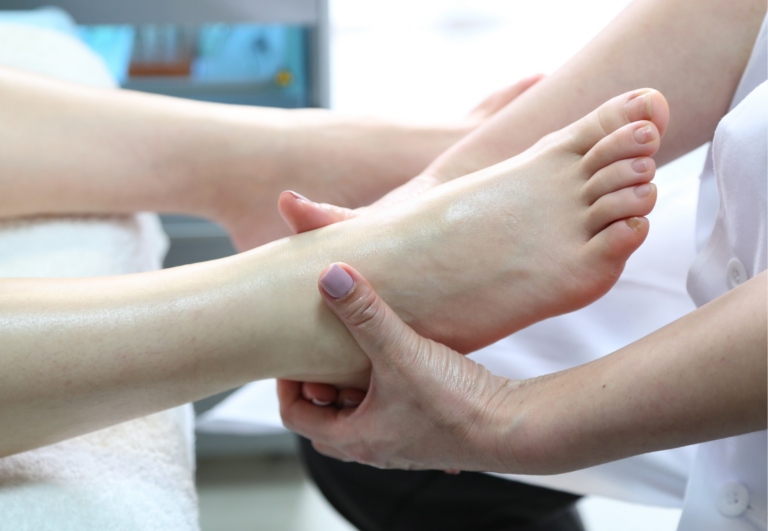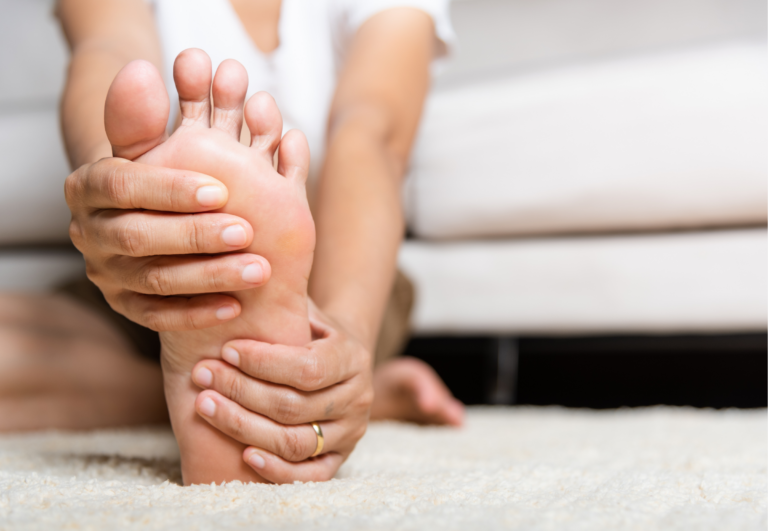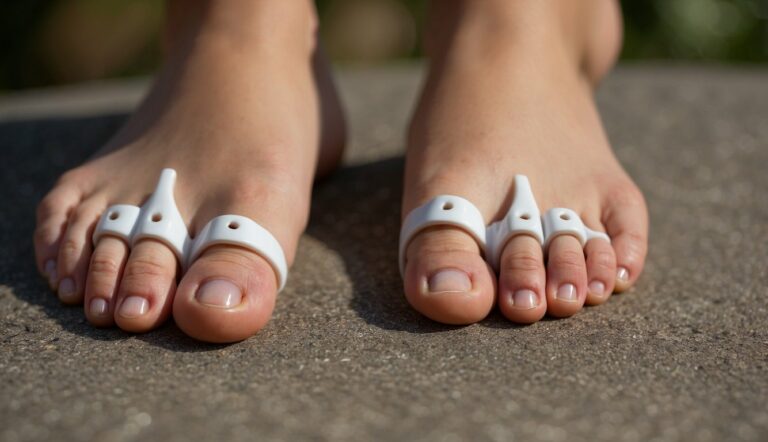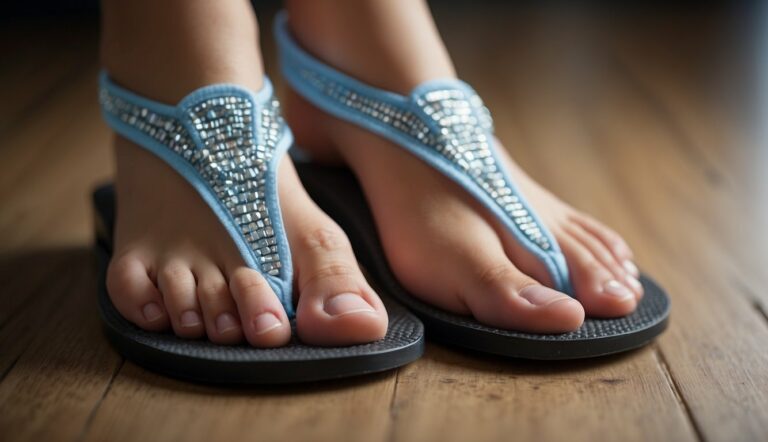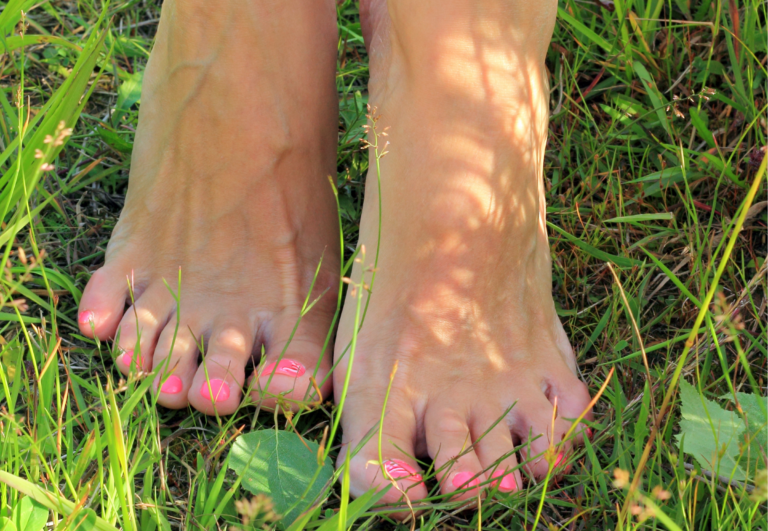How do Toe Spacers Work? Unveiling the Mechanics of Foot Alignment
Toe spacers are simple yet ingenious tools designed to improve foot health and comfort. From my experience, they work by gently separating the toes to realign them to their natural position. This can help alleviate the pressure and friction that often leads to pain and discomfort, especially for those of us who spend long hours on our feet or squeeze them into tight footwear.
The design and materials of toe spacers play a crucial role in their effectiveness. They’re usually made from soft, flexible materials like silicone or gel – a choice that ensures they adapt to the shape of the foot while providing the necessary support. It’s these qualities that make them an integral part of my daily routine to maintain toe alignment and avoid common foot problems.
Wearing toe spacers regularly has also been shown to strengthen the intrinsic muscles of the foot. This strength is important because it can contribute to better balance and overall foot function. By incorporating toe spacers into my regimen, I’ve noticed a significant increase in comfort, which is likely attributable to the improvement in toe alignment and foot strength.

Anatomy of Toe Spacers
When choosing toe spacers, it’s important to consider their type, material, and design to ensure they meet your needs for balance, flexibility, and comfort. These devices are intended to improve toe alignment and aid with conditions like bunions.
Types and Materials
Toe spacers come in various materials, each with its unique benefits. For example, silicone toe spacers are praised for their durability and comfort, whereas gel options are softer and can adapt more readily to the contours of your feet. Additionally, foam spacers offer a cost-effective alternative with a lighter feel but may not last as long as their silicone and medical-grade gel counterparts.
- Silicone: Durable, often medical-grade, resistant to degradation.
- Gel: Soft, pliable, conforms well to the foot.
- Foam: More affordable, lighter feel, less durable over time.
Sizing and Fitment
The effectiveness of toe spacers greatly depends on proper sizing and fitment. Ill-fitting spacers can actually worsen discomfort instead of providing relief. Sizes typically range from small to large, catering to various foot sizes, and special designs are available to accommodate narrow toe boxes.
- Small: Best for individuals with naturally narrow feet.
- Medium: Suits most average-sized feet.
- Large: Ideal for wider feet or those with significant bunion development.
Design Considerations
The design of toe spacers plays a crucial role in their function. I search for designs that ensure a natural spread of the toes without overextension. High-quality spacers aim to mimic the foot’s natural shape, improving balance while enhancing mobility and comfort. The goal is to correct alignment, particularly of the big toe, without causing additional pressure or pain.
- Corrective vs. Comfort: Some focus on correcting toe alignment, while others prioritize comfort.
- Bunion Relief: Features to ease the pain and pressure associated with bunions.
- Flexibility: Materials that allow for natural foot movement.
By understanding the anatomy of toe spacers, you can make an informed decision based on your needs and the unique specifications of your feet.
Usage and Practices
Incorporating toe spacers into your daily routine can enhance foot health and potentially aid in the recovery of certain foot-related issues. Specific guidelines about wear time and recommended practices can optimize their effectiveness.
Incorporating Into Routine
I find that introducing toe spacers gradually into my regular routine has the best results. They can be worn while at home, typically without shoes, as most footwear may not accommodate them. I recommend starting with periods of rest, perhaps while sitting or lying down, before using them during exercise. Over time, as the feet adapt, toe spacers can be a beneficial addition to yoga and stretching practices.
Duration and Frequency
The duration of wear can vary, but it’s essential to listen to your body. Initially, I might only wear them for about 10-15 minutes a day, slowly increasing to one hour or more as comfort allows. For the best recovery results, consistent daily use is more effective than sporadic long sessions. It’s the regular, cumulative exposure that contributes to long-term foot health.
Professional Recommendations
Consulting a podiatrist or foot surgeon for personalized advice is highly advisable, especially for those with existing foot conditions. These professionals can provide tailored programs and recommend the frequency and time of use for your specific case.
They will base their recommendations on a host of factors including exercise routines, the need for recovery after workouts, and shoes that will work well with toe spacers. A DPM (Doctor of Podiatric Medicine) can also suggest specific exercises that complement the use of toe spacers for optimal results.
Considerations Before Use
When thinking about toe spacers, it’s crucial to consider the specific foot health conditions, choose the correct product, and be aware of potential complications that may arise.
Foot Conditions and Health
Before using toe spacers, individuals with existing foot conditions such as bunions, neuromas, ingrown toenails, or arthritis should consult with a podiatrist. Those with diabetes and rheumatoid arthritis are at a higher risk for complications due to poor circulation or nerve damage that could affect their response to toe spacers.
Choosing the Right Product
Choosing the right toe spacers involves assessing:
- Materials: Opt for hypoallergenic, flexible silicone spacers that can adapt to your foot’s shape.
- Size and Fit: Ensure the spacers are the correct size to avoid discomfort.
- Brand: Consider highly-rated brands like Pedifix or Mind Bodhi for quality assurance.
| Price Range | Brands | Features |
|---|---|---|
| $ | Generic | Basic functionality |
| $$ | Mind Bodhi | Ergonomic design |
| $$$ | Pedifix | Enhanced materials |
Potential Complications
Be vigilant about:
- Swelling or Inflammation: If spacers cause increased swelling or inflammation, discontinue use immediately.
- Blisters or Irritation: Monitor any skin reactions, such as blisters or irritation. If these occur, reevaluate the fit and material of the product.
- Overuse: Wearing toe spacers for too long can stress the feet. Start with short intervals.
Benefits of Toe Spacers
Toe spacers can provide significant benefits in terms of comfort and foot health. I’ll guide you through how they can alleviate foot pain, correct toe deformities, and improve foot dynamics.
Alleviating Foot Pain
By spreading the toes, these simple devices can reduce pressure on bunions, corns, and calluses. They’re helpful in managing foot pain and can promote better balance and gait. For those with plantar fasciitis, toe spacers might offer pain relief by allowing the foot muscles to stretch and strengthen, potentially easing the discomfort.
Correcting Toe Deformities
If you suffer from hammertoes or overlapping toes, toe spacers are useful tools in your arsenal. They work by holding your toes in the correct position, thus providing a non-surgical option to help realign your toes and reduce the risk of bunions and hallux valgus.
Improving Foot Dynamics
Toe spacers improve foot dynamics by promoting natural toe spread during movement. This natural alignment can lead to improved posture and balance, as well as enhanced foot strength.
For athletes, incorporating toe spacers into their routine is a podiatrist-recommended exercise to optimize foot function. Using toe spacers can contribute to a stronger foundation, which is critical for anyone on their feet regularly.
Comparing to Alternatives
When considering how to manage toe-related discomfort or deformities, we find a variety of options ranging from non-surgical interventions like toe spacers to more invasive surgical procedures. Let’s explore how these different solutions measure up.
Orthotics and Insoles
Orthotics and insoles are a popular alternative designed to provide arch support and cushioning, potentially alleviating foot pain. Unlike toe spacers which are focused on toe realignment, orthotics aim at improving the overall foot structure.
For those dealing with flat feet or high arches, insoles can be a go-to solution for pain relief and support. High-quality insoles offer a balance of comfort and support and can be particularly beneficial in modern footwear where such attributes might be lacking.
Surgical and Non-Surgical Treatments
Comparatively, surgical interventions offer a permanent alteration to the foot’s structure. Bunion surgery, for example, is more invasive than using a bunion corrector or a toe spacer but is a long-term solution for severe cases.
Non-surgical treatments, like night splints, offer a middle ground, often used for ongoing pain management and corrective positioning during sleep, providing continuous slow pressure on the toe.
Footwear Choices
Shoes play a critical role in foot health. Choosing footwear wisely, such as opting for barefoot shoes or avoiding prolonged use of high heels, can prevent or alleviate the need for additional foot support.
Good shoes provide natural cushioning and allow the foot to maintain its natural shape, unlike high heels which can lead to foot deformities. Toe spacers can help in realigning toes distorted by tight or poorly designed shoes and offer an additive benefit by improving toe function when paired with appropriate footwear choices.
